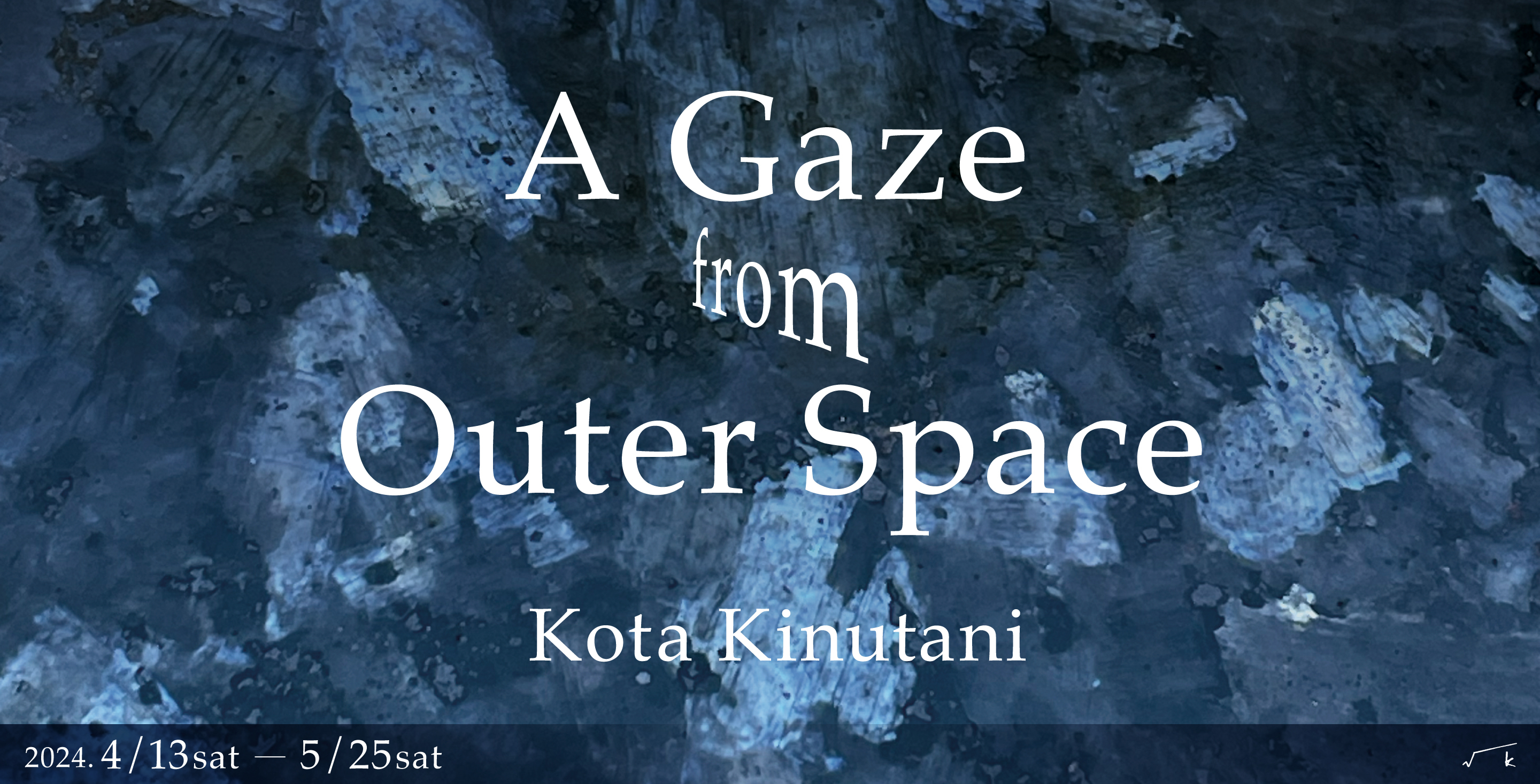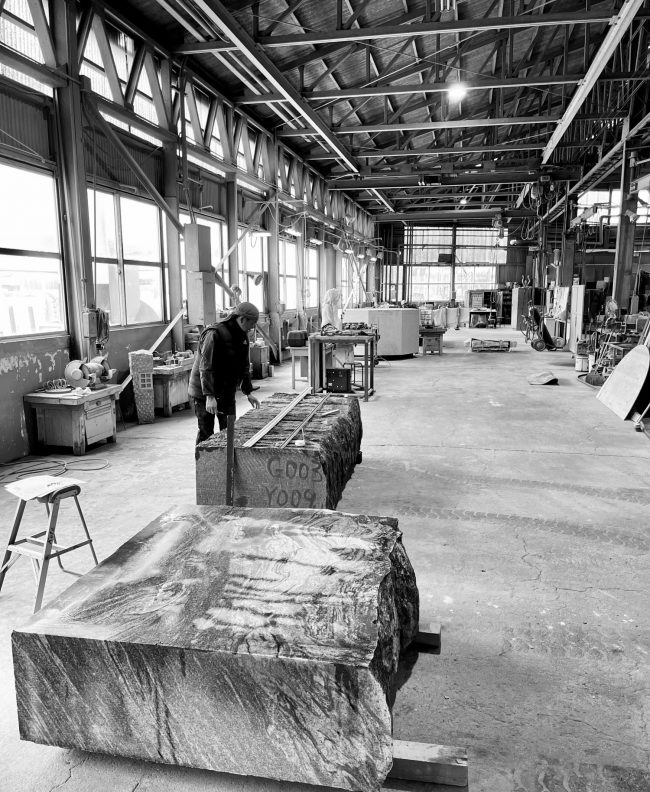

Kota Kinutani, A Gaze from Outer Space
Dates| April 13 (Sat) to May 25 (Sat), 2024
Venue| √K Contemporary
Organizer| Patron Project, √K Contemporary
Curator| Maiko Kikuchi (Director of Patron Project, Art Writer)
Collaborators|Masakazu Iso, Shiro Uchiyama, Chika Habazaki, Atsuya Ishida
* We will be closed on the last day of Golden Week, May 6th, Monday.
√K Contemporary is proud to announce the opening of stone sculptor, Kota Kinutani’s highly anticipated solo exhibition, A Gaze from Outer Space. On view from April 13 (Sat) to May 25 (Sat), 2024, the exhibition will span across three floors of the gallery, from the basement to the 2nd floor, marking the artist’s most ambitious show to date. From large-scale installations to smaller works, A Gaze from Outer Space offers viewers a chance to view a wide range of the artist’s oeuvre.
Inspired by the stone pavements and fountain sculptures he encountered in his youth in Rome and Venice, Kota Kinutani’s works are an ode to the experiences of his formative years. During University, Kinutani researched ancient ruins and stone carvings, studied petrology, and participated in Artist in Residencies. After receiving his Master’s Degree from the Tokyo University of the Arts in 2003, Kinutani grew enamored by the blue granite of Brazil and, through funding from the Agency for Cultural Affairs, Government of Japan’s Program of Overseas Study for Upcoming Artists, began his studies at the University of São Paulo. In 2008, the artist produced Sonho e Gratidão, a monument made in commemoration of the 100th Anniversary of Japanese Immigration to Brazil, in Carmo Park, São Paulo.
Sonho e Gratidao (2008) São Paulo Carmo, Brazil
One defining charm of Kinutani’s work is its tactile nature. Urging his viewers to forge a connection with his works, the artist encourages his viewers to interact with his work by touching them. A notion, that the artist calls “creative-perceptual sculpture,” Kinutani believes that, by touching stone, a material that bears the history and memories of earth, we can gain valuable knowledge that may help guide us towards the future.
A key exhibiting work of the show, Infinite Arc is part of a massive circular structure that spans a radius of several kilometers. Evoking a sense of the invisible, its presence signifies the infinite, invisible connections that extend beyond its limited, visible space. Going beyond notions of borders and categorization, Kinutani’s works give viewers a glimpse into the future and offer alternative, metaphorical utopic solutions for humanity. In addition to numerous events featuring special guests held during the show, an essay by Dr. Tetsuya Oshima (Professor, Tama Art University / Director, Tama Art University Museum), which provides an art historical approach to Kinutani’s works, is available for viewing via the gallery’s website and at the exhibition venue.
Artist Statement
When looking at the rocks that were born billions or millions of years ago, I am reminded of the fragility of life.
Simultaneously, I also realize how the Earth, too, is one large living organism.
One day, in the future, all life, including us, may need to leave Earth.
I view rocks as miraculous gifts from the Earth, and I feel great joy in interacting with them through my five senses, receiving and conveying their messages through my creations.
With every fiber of my being, I would like to continue expressing my love for stones and appreciation for the earth.
― Kota Kinutani
Events
From talk event to gallery tours, numerous special events will be held during the course of the exhibition. In addition, for three days during the show, a unqiue coffee event inspired by the works will be held at the 2nd floor bar space.
Event #1 | Kota Kinutani Discussion
Guests: Tetsuya Oshima (Professor, Tama Art University / Director, Tama Art University Museum) × Taku Umezawa(lawyer/collector)
Moderator: Maiko Kikuchi (Director, Patron Project, Art Writer)
The tripartite discussion with the artist features Tama Art University Professor and author of the exhibition’s essay, Tetsuya Oshima, and Kinutani’s most faithful collector, Taku Umezawa. From themes of Japanese art history and how the artist’s work fits into the history of stone sculpture to how the artist views his work and why he works with stone, the talk will address various topics and provide deep insight into the artist and his work. (Japanese only)
Schedule: May 18 (Sat) 3 pm to 5 pm
Admission: Free
Event #2 | Artist-led Gallery Tour
Artist, Kota Kinutani will hold gallery tours every day from May 1 to 5 during Golden Week.
During this event, the artist will guide visitors through his exhibition and offer insight into each of his works- from their concept to the story of each stone, their form, as well as the exhibition’s theme. We urge you all to please take part in this wonderful occasion.
【Gallery Tour Dates】
May 1 (Wed) to May 5 (Sun)
3pm to 4pm
Reservations are not required, so please feel free to join during any of the scheduled dates above.
Event#3 | Barista-led Interactive Coffee Event
Lawyer, close friend, and collector of Kinutani and certified barista, Taku Umezawa will host a special event during the following dates during the exhibition. On this occasion, participants can enjoy a cup of coffee inspired by their favorite Kinutani work, the stone’s origin, its context, and its aesthetic. Admission is free and all participants are welcome.
*As each cup of coffee will be catered to each participant, it will require some time to prepare. As such, please be aware that additional waiting times may incur during peak times.
Dates:
April 13 (Sat) 3pm to 7pm
April 19 (Fri) 5pm to 8pm *
May 11 (Sat) 3pm to 7pm
*Patron Project members will be given precedence for the April 19 event. For reservations, see: https://patronproject20240419.peatix.com/ (Japanese only)
Event #4 | Patron Project
Featuring the artist, participants will have the opportunity to touch and share a “dialogue” with the works. Further details on the event and reservations will be announced on the Patron Project website and social media pages. (Reservations required・with admission fee)
Dates: April 27 (Sat) 1 pm to 3 pm
Essay|Tetsuya Oshima, Kota Kinutani’s Sculpture
Written especially for this exhibition, an essay by Dr. Tetsuya Oshima (Professor, Tama Art University / Director, Tama Art University Museum)’s essay, which explores Kota Kinutani’s works from the perspective of an art historian, can be read below.
Click here to read Dr. Tetsuya Oshima’s essay, Kota Kinutani’s Sculpture.
Media|THE ART HOUSE#39 (Nippon Television Network Corporation / Broadcast Date December 12, 2023)
See below for Kota Kinutani’s special feature on the Japanese show, THE ART HOUSE.
ARTISTS

Kota Kinutani was born in 1973 as the eldest son of the painter, Koji Kinutani. He spent his early years in Rome and Venice and, through the influence of post-war sculptor, Yoshitatsu Yanagihara, began pursuing sculpture in 1991. Kinutani graduated from the Nihon University College of Art in sculpture in 1996 and completed his master’s degree in sculpture at the Tokyo University of the Artsʼ Graduate School of Fine Arts in 1998. In 2002, the artist completed his doctoral course in sculpture at the Tokyo University of the Artsʼ Graduate School of Fine Arts. Following his doctorate, the artist would embark on a range of pursuits; from researching at the University of São Paulo of Brazil to teaching at universities such as Nagoya University of Arts, Osaka University of Arts, and Tokyo Polytechnic University. In 2008, the artist produced a monument in commemoration of the 100th anniversary of Japanese Immigration to Brazil. In 2019, Kinutani took part in numerous, significant projects worldwide, including the production of a monument that commemorated the Japanese Emperor Naruhitoʼs enthronement.
I spent my early years in Rome and Venice. Every day, I clambered onto the sculptures of the fountains in the piazza. I remember that in my playtime I was totally absorbed in playing the role of the Monkey King, roaming the skies freely with the figures of the sculptures reflected in the water. In Asia, we have the notion of un-kon-ka-ei (cloud-root-passing-shadow)—whereby the stones of the earth embody the spirits of the universe and that organic connections link stones and clouds. If we can keep our minds open to our experiences, we can feel our close connection with nature. In the innocence of childhood, I was able to touch the hearts of the stones, and this experience gave me the idea of “creative-perceptual sculpture.” The main difference between this and the conventional way of appreciating sculpture is that I encourage people not just to look at the work but to touch it with their hands or climb on it. I invented the name “creative-perceptual sculpture” because I love it when people use all five senses to explore my work and engage in the conversation: tapping on them to listen to the sound they make, sniffing to see what they smell like, or analyzing their chemical makeup. All the answers that people need to live their lives can be found in nature. I will be happy to know that people see this as an opportunity to learn from nature, in a spirit of reverence for nature.
― Kota Kinutani(quoted from the artist website: https://kotakinutani.com/about/ )

Kota Kinutani was born in 1973 as the eldest son of the painter, Koji Kinutani. He spent his early years in Rome and Venice and, through the influence of post-war sculptor, Yoshitatsu Yanagihara, began pursuing sculpture in 1991. Kinutani graduated from the Nihon University College of Art in sculpture in 1996 and completed his master’s degree in sculpture at the Tokyo University of the Artsʼ Graduate School of Fine Arts in 1998. In 2002, the artist completed his doctoral course in sculpture at the Tokyo University of the Artsʼ Graduate School of Fine Arts. Following his doctorate, the artist would embark on a range of pursuits; from researching at the University of São Paulo of Brazil to teaching at universities such as Nagoya University of Arts, Osaka University of Arts, and Tokyo Polytechnic University. In 2008, the artist produced a monument in commemoration of the 100th anniversary of Japanese Immigration to Brazil. In 2019, Kinutani took part in numerous, significant projects worldwide, including the production of a monument that commemorated the Japanese Emperor Naruhitoʼs enthronement.
I spent my early years in Rome and Venice. Every day, I clambered onto the sculptures of the fountains in the piazza. I remember that in my playtime I was totally absorbed in playing the role of the Monkey King, roaming the skies freely with the figures of the sculptures reflected in the water. In Asia, we have the notion of un-kon-ka-ei (cloud-root-passing-shadow)—whereby the stones of the earth embody the spirits of the universe and that organic connections link stones and clouds. If we can keep our minds open to our experiences, we can feel our close connection with nature. In the innocence of childhood, I was able to touch the hearts of the stones, and this experience gave me the idea of “creative-perceptual sculpture.” The main difference between this and the conventional way of appreciating sculpture is that I encourage people not just to look at the work but to touch it with their hands or climb on it. I invented the name “creative-perceptual sculpture” because I love it when people use all five senses to explore my work and engage in the conversation: tapping on them to listen to the sound they make, sniffing to see what they smell like, or analyzing their chemical makeup. All the answers that people need to live their lives can be found in nature. I will be happy to know that people see this as an opportunity to learn from nature, in a spirit of reverence for nature.
― Kota Kinutani(quoted from the artist website: https://kotakinutani.com/about/ )


